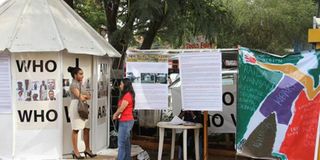A question of identity: giving voice to diversity discourses

A scene from the exhibition at Diamond Plaza, Nairobi. PHOTO | JOHN FOX
What you need to know:
- he histories of nations such as England and Germany are long, and the history of Kenya is short
Some food for thought. One of the things that have struck me about the World Cup this year is the different ways in which Europeans and Africans give their support to teams that are not of their own countries.
If you are English, say, or German or Dutch, and France is playing, say, Ghana – then you would inevitably be supporting Ghana. But if you are Ghanaian, and Cameroun is playing England, Germany or the Netherlands – then you would most likely be supporting Cameroun. Isn’t that so? Kenyans will support whatever African team is playing a non-African one, right?
What does this signify? It shows that Europeans are much more nationalistic than Africans. The national rivalries in Europe — based on long histories and expressed in different languages — cut much deeper than in games of football.
They led in the last century to two, so-called world wars. And, after the collapse of the Soviet Union that put a blanket cover of communism over many European countries, there has been a resurgence of conflicts and a fragmentation in the name of nationhood.
Perhaps, then, you can imagine how I felt when I first came to teach in Kenya in the late 1960s and heard people saying, and read people writing about, the importance of “building the nation”. For me, national feeling was something to be challenged and held in check.
But, the histories of nations such as England and Germany are long, and the history of Kenya is short. President Jomo Kenyatta was born before the nation was created and he outlived its life as a colony. Kenya’s boundaries were drawn, and its name was given, by the colonialists.
If you look back to what was being reported in the Daily Nation in the year before the first Madaraka — by the peoples of the Coast, the North and the West — you will appreciate the achievement of leaders like Jomo Kenyatta and Oginga Odinga in holding the country together. Even so, after decades of Independence, Kenya had to hold a competition to design a national dress – because there wasn’t one.
Also, as well as ethnic divides among the majority Africans, there were the racial divides. For a time, the colonial mentalities persisted.
Once, in the dining room of Mombasa’s Oceanic Hotel back in 1968, I overheard someone saying to his friends: “Those were the days: British efficiency, Indian hospitality, and African service”. And, of course, with the violence that broke out after the 2007 elections, it was a grim reminder of how ethnic rivalries can still be enflamed.
In light of all this, I was fascinated by something that happened last weekend at the Diamond Plaza, Parklands, a project called “Who I am. Who we are”, one that describes itself as “a project about the idea of Kenyan nationhood, and how it is embodied through our sense of identity, as well as our everyday interactions”.
The idea of the project is to collect people’s perceptions of themselves as Kenyans, their relationships with other Kenyans, and their views about key events in Kenya’s 50 years: Independence, post-election violence, the Constitution (2010), and the 2013 elections.
RECORD THEIR STORIES
In the last five months, the project initiated by two artists — Xavier Verhoest and Wambui Kamiru — has collected over 600 responses.
It uses two methods: people are invited to make life-size paintings called “body mapping” — letting their pictures talk for them — others are invited into a “silent room” where they can record their stories. Here are examples of people talking about their paintings:
An Asian woman, a director of a skills development company, tells how she appreciates having been brought up in a far less palatial home than her grandparents had in Parklands. “We were privileged to live with the different Kenyan African neighbours,” she says.
“Indian, Ismaili, and many young Kenyans who had brought home wives from Yugoslavia, Russia, Czechoslovakia and Somalia. Without realising it, I grew up accepting Kenyan Africans and Indians as one people.”
The second example is about a Kenyan who has an African, Arab and an Indian, heritage. He tells how, growing up in Western Kenya, he experienced racism from both sides of the divide. He focuses on the election violence of 2007.
“The people who were killed taught us about our morality and humanity — and how far we go to destroy ourselves ... It was a lesson for all of us that blood should not be shed for whatever reason, especially for politics.”
Back to football, I watched Italy defeat England the other night. Both had distinctive players with their different roles — but Italy played more as a team. It was a good illustration that diversity need not mean disunity. It should be something to celebrate and used to advantage. But that can happen, of course, only when there is a shared agenda.
John Fox is Managing Director of iDC





